Gettysburg’s Own Angels of the Battlefield
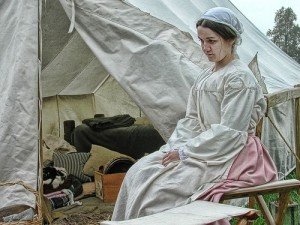 The importance of the humanitarian effort voluntarily undertaken by the women of Gettysburg to the thousands of men who lay searing in the July sun cannot be overstated. They dedicated themselves to the care of the wounded from both armies beginning in the mid morning hours of July 1, 1863, long before military medical personnel arrived.
The importance of the humanitarian effort voluntarily undertaken by the women of Gettysburg to the thousands of men who lay searing in the July sun cannot be overstated. They dedicated themselves to the care of the wounded from both armies beginning in the mid morning hours of July 1, 1863, long before military medical personnel arrived.
Backstory
Throughout the month of June 1863 there had been repeated alarms in Gettysburg: “The Rebels are coming.” Suddenly on Friday June 26 a contingent of General Robert E. Lee‘s army galloped up Chambersburg Street firing their pistols into the air while citizens scrambled to the safety of their homes. They plundered and ate everything within their reach and left the following day.
On June 30 the citizens of Gettysburg – the majority of them women and children – turned out to welcome General John Buford (who would die of typhoid fever six months later) and his 3,500 troopers as they passed through Gettysburg.
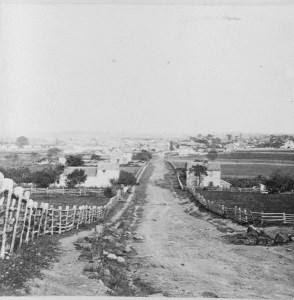
Confederate General Henry Heth and his 6,000 infantrymen of General A. P. Hill‘s corps approached Gettysburg early on the morning of July 1, 1863. About 8:00am they made contact with Buford’s 3,000 horsemen posted along McPherson Ridge a mile west of the town. The rest, as they say, is history.
Lee’s Army of Northern Virginia and General George Meade‘s Army of the Potomac collided in the crossroads town during the first three days of July 1863, leaving nearly 60,000 casualties, the highest number of any single engagement in American history. The Confederate dead were estimated at 4,500 with more than 5,000 missing and 18,750 wounded. The Union Army suffered more than 3,000 deaths with 5,365 missing and more than 14,000 wounded. Each side also took about 5,000 prisoners, many of them wounded.
Nursing the Wounded at the Battle of Gettysburg
The first three days of July 1863 were brutally hot and their work was difficult to say the least, but the women of Gettysburg responded with dedication and bravery. By 10am on July 1st a ragged column of walking wounded began to gather at the lower ends of Chambersburg and West Middle Streets looking for medical aid.
The volunteer women nurses provided the only care the soldiers received until medical professionals arrived. By late morning Army surgeons had showed up and were looking for sites to set up hospitals. The large warehouse buildings and the railroad station itself were the first chosen, but they rapidly filled to capacity and overflowed. By then many injured were arriving by the unfinished railroad bed which ran parallel to the Chambersburg Pike.
Mary McAllister
That morning Mary McAllister handed out cups of water to Union soldiers as they raced down Chambersburg Street toward the battle. Mary and a neighbor then responded to the need for nurses at St. Francis Xavier Catholic Church, while the battle was still raging nearby. A detailed narrative of her experiences, published in the Philadelphia Inquirer in 1938, recounted how exhausting, grueling and gruesome the ordeal was.
I gathered up sheets and water and Mrs. [Nancy] Weikert and I went to the church and we went to work. They carried the wounded in there as fast as they could. We took the cushions off the seats and some officers came in and said, ‘Lay them in the aisles.’ Then we did all we could for the wounded men… wetting cloths and putting them on the wounds…
Many of these impromptu nurses were initially overwhelmed by the sights and sounds in the makeshift hospitals. Unfortunately, 70% of the battlefield injuries were caused by minie balls that shattered bone and required amputations. Working in the church where pews were used as beds, Mary watched surgeons amputate legs and arms and then throw them out the window. When shells started hitting the church Mary became frightened and wanted to go home:
Well, they begged me not to go, but I went out and there the high church steps were full of wounded men and they begged me not to try to cross the street. Our men were retreating up the street. Many wounded ones who could walk carried the worst ones on their backs. I said, “Oh, I want to go home.” So they let me go at last. I struggled through the wounded and the dead and forgot the horror in the fright.
I was as far up as Buehler’s drug store before I got across the street and got home. When I came to the door it was standing open and the step was covered with blood. I could hardly get through for the dining room was full of soldiers, some lying, some standing. Some ran in to get out of the shooting. The rebels were sending grapeshot down the street and everyone who was on the street had to get into the houses or be killed and that is the way some of these Union men got into our house.
The victorious Confederates did not interrupt the surgeons at the church, but a guard was placed at the entry while homes were searched for Union men desperately hiding to avoid capture. When the Confederate soldiers began to tear up the fence around the McAllister home, the Union troops inside surrendered, so as not to further endanger the home.
The seriously wounded were left behind. When some Confederate surgeons arrived, they suggested to the McAllisters that a red flag marking the house as a hospital would save it from harm. As Mary administered to the seriously wounded left behind, her sister Martha put a red shawl on a broomstick and hung it from an upper window.
By the evening of July 1, 1863, the town of Gettysburg had become one large hospital for hundreds of wounded soldiers packed into churches, schools and private homes, where blood stained the floors and furniture. It was a grim reality that would last for weeks to come. As the fighting intensified with the arrival of more elements of both armies, the flow of wounded into town increased dramatically.
Harriet Bayly
A civilian living north of town, Harriet Bayly was driven by compassion to nurse the wounded Confederates on her family’s property. She took a basket of bread, butter, wine and bandages into the field and tended to several wounded soldiers who had been baking under the sweltering July sun for hours.
I had been hearing the pitiful cry of “water, water,” all around me, and when I found that these men had none for 24 hours, I rose up in my wrath and turning to the Rebels who were walking around me, I said, “Is it possible that none of you will bring water to these poor fellows?” An officer heard me and finding that what I said was true, he ordered a lot of men to mount and bring all that was necessary.
On July 4, 1863, Lee’s army, which had lost more than one-third of its troops, began the long retreat toward the Potomac River, where they would cross back into the safety of Virginia. Wagon after wagon of injured soldiers followed the army, but approximately 7,000 were left behind because they were too ill to travel. This left more than 25,000 men who not only needed medical care, they needed to be bathed and fed by a tiny town comprised mostly of women.
Unfortunately, many of the Army surgeons, and the official nurses who always traveled with them, marched away with the remaining troops on July 4, 1863, so the town was left to struggle with the aftermath until more help arrived.
Sallie Robbins Broadhead
From mid-June through late July, Sallie Robbins Broadhead kept a daily diary, providing us with a graphic first hand account of the ordeal endured by the citizens of Gettysburg. Broadhead wrote in her diary on July 5, two days after the battle ended:
What a beautiful morning! It seems as though Nature was smiling on thousands suffering. One might think, if they saw only the sky, and earth and trees, that everyone must be happy; but just look around and behold the misery made in so short a time by man. Early this morning I went out to the Seminary, just outside of town, and which, until the retreat, was in the hands of the enemy.
What horrible sights present themselves on every side, the roads being strewn with dead horses and the bodies of some men, though the dead have nearly all been buried, and every step of the way giving evidence of the dreadful context. Shall we – for I was not alone – enter the building or return home? Can we endure the spectacle of hundreds of men wounded in every conceivable manner, some in the head and limbs, here an arm off and there a leg, and just inside a poor fellow with both legs shot away?
It is dreadful to behold, and, to add to the misery, no food has been served for several days. The little we have will not go far with so many. What can we do? Is the only question, and the little we brought was distributed. It is heartsickening to think of these noble fellows sacrificing everything for us, and saving us, and it out of our power to render any assistance of consequence. I turned away and cried.
While nursing three men in her own home, Sallie wrote on July 11:
The atmosphere is loaded with the horrid smell of decaying horses and the remains of slaughtered animals, and, it is said, from the bodies of men imperfectly buried. I fear we shall be visited with pestilence, for every breath we draw is made ugly by the stench.
When Broadhead published her diary, The Diary of a Lady of Gettysburg, Pennsylvania, in 1864, she donated 75 copies to the Sanitary Commission. She had seen firsthand the good work that the Sanitary Commission had done by providing millions of pounds of food, clothing, ice and medical supplies to the overwhelmed town immediately after the battle.
Volunteer Nurses From Afar
Fortunately, hundreds of volunteer doctors and nurses arrived in the small Adams County town in the days following the battle to help care for the tens of thousands of wounded soldiers left behind when the Army of Northern Virginia and the Army of the Potomac withdrew.
After the fight ended, several members of the Sisters of Charity, the order founded in 1809 by Mother Elizabeth Ann Seton, set out from Emmitsburg, Maryland with Father Francis Burlando for Gettysburg. More Sisters arrived the following day; they cared for one group of nearly 200 men in the field for three weeks until they were fit to travel. Margaret Hamilton, a member of the Sisters of Charity who came to Gettysburg as a nurse, wrote:
The weather was extremely warm, and the vast number of the wounded made careful attention to their wounds impossible; and upon their arrival at the hospital many wounds were full of vermin, and in many cases gangrene had set in, and the odor was almost unbearable. The demand on our time and labor was so increased that the number of nurses seemed utterly inadequate and the hospital presented a pure picture of the horrors of war.
Beginning with Sophronia Bucklin from New York, several experienced Civil War nurses began arriving at the field hospitals. Bucklin was followed by Georgeanna Woolsey and Helen Gilson, Hospital Transport Service Nurses; eighteen-year-old Mary Alice Smith from Greencastle, Pennsylvania; Cornelia Hancock, a young Quaker who traveled with the troops and quartered with them in winter; and many others.
The service of these experienced nurses was invaluable, and theirs were often the last faces many soldiers saw on earth. One soldier described Helen Gilson in this way:
She sang for them, and, kneeling beside them, where they lay amidst all the agonizing sights and sounds of the hospital wards, and even upon the field of carnage, her voice would ascend in petition, for peace, for relief, for sustaining grace in the brief journey to the other world, carrying with it their souls into the realms of an exalted faith.
Mrs. H. R. Spencer (her first name has been lost to history) was a nurse who traveled with a New York regiment in her husband’s corps. She was on the battlefield on July 1, attending to the wounded while under fire, and later worked at a tiny church just four miles from Gettysburg that held sixty wounded. She and the surgeons did what they could, but the trains with instruments, chloroform and other medical supplies were still fourteen miles away on July 4. Even after the regimental hospital was dismantled, she traveled with the New York men, caring for them on the cars.
Annie Etheridge
Nurse Annie Etheridge came to Gettysburg with the 3rd Michigan regiment. Etheridge was later awarded the Kearny Cross, which was usually bestowed on Union officers who had performed acts of extreme bravery and heroism in the face of the enemy. One of the Michigan soldiers recalled her actions on the field:
I remember her moving softly amongst the wounded kneeling upon the ground beside them and tenderly bathing and dressing their wounds. Her low woman’s voice was music to their ears and her kind words of sympathy and encouragement and gentle reproof for undue and dangerous restlessness seemed almost angelic to the sufferers whose eyes followed her from place to place as she went from one to another. Her presence alone was of incalculable benefit… she filled a place there that no man could fill….
Medal of Honor recipient Brevet Major General Clair A. Mulholland observed Annie during the second day at Gettysburg during fighting around the Peach Orchard:
Amidst cannon shot that was throwing up loose dirt around the farm… a woman on horseback and in uniform galloped back from the line of battle, asked for some information, and quickly returned to the front again. She was a nurse of the Third Corps, Anna Etheridge and was directing the removal of the wounded. She was cool and self-possessed and did not seem to mind the fire.
Euphemia Goldsborough
Some Southern nurses came too, including Miss Euphemia Goldsborough from Baltimore. Though she was not treated well by the Yankees, she arrived at Gettysburg on July 12 and worked there for nine weeks. She went immediately to the Pennsylvania College which was full of the Confederate wounded. As the supply of food, blankets and medical supplies improved, mainly due to the work of the Sanitary Commission, she discovered that Southern soldiers were treated the same as the Union wounded.
However, many of the Southern men needed new clothing. Federal Provost Marshals were concerned that better clothing might help them to escape, but they were forced to allow the Rebels’ tattered uniforms to be replaced with clothing provided by the Sanitary Commission; they did however ban them from having shoes or boots. This did not deter Euphemia. She smuggled shoes in under the hoops of her skirt and smuggled out letters to the soldiers’ families via her friends in Baltimore.
Pressure was put on the medical staff to get the Confederates into prison camps. As the wounded were being moved away by railroad in ever increasing numbers, Euphemia left Gettysburg after the death of one of her favorite patients. After returning to Baltimore, her sister said that “she was never the same joyous girl again.” She then decided to work at the large hospital at Point Lookout, Maryland, where wounded Confederate prisoners were held.
Euphemia came under investigation for aiding patients to escape. A letter from her to a Confederate was intercepted and on November 23, and a Federal Provost Marshal’s detail arrived and searched her house. She was arrested and charged with treason. Found guilty she was sent by truce steamer to Virginia for the duration of the war, and she became quite a celebrity in Richmond. President Jefferson Davis gave her a post at the Treasury Department, and she also worked in the many hospitals there.
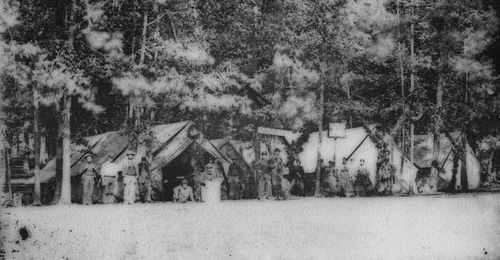
Image: Nurses and other medical personnel standing before the U.S. Sanitary
Commission’s tents at Camp Letterman near Gettysburg
Camp Letterman Hospital
Dr. Jonathan Letterman, Medical Director of the Army of the Potomac, and his staff had an overwhelming job ahead of them. Before the battle ended, he sent his ambulance corps to move the wounded into more centralized corps hospitals. Surgeons from the various regiments worked for days without rest to treat the wounded; still, many soldiers went without care or treatment for several days.
Orders were issued on July 5, 1863 to establish a central hospital on the George Wolf Farm, east of Gettysburg on the York Pike; it was named Camp Letterman. The farm was adjacent to the main road and the railroad where a depot was established. Arriving trains would deliver a continual flow of supplies and transport convalescents to permanent hospitals in Philadelphia, Baltimore and Washington, DC.
Wounded soldiers were taken from the field by horse-drawn ambulances to this new hospital where they were housed in large canvas tents. Unlike field hospitals, the new camp had cots with clean sheets and pillows. Nurses were assigned to each of the tents and surgeons stayed busy around the clock treating the more serious patients. Cases considered too serious to move remained at the camp while an average of 800 men per day were shipped by rail to hospitals in northern cities.
By August 7, 1863, all of the corps and field hospitals were closed and Camp Letterman was the only hospital remaining with over 3,000 patients. Union and Confederate wounded were both treated there by army doctors and personnel of the United States Christian Commission and the United States Sanitary Commission. Due to the care of Gettysburg nurses and other volunteers and 650 surgeons, 75% of the amputees survived.
SOURCES
McAllisters at Gettysburg
Gettysburg in the Civil War
Gettysburg: The Civil War’s Costliest Battle
Persephone in the River Phlegethon; or, the Women at Gettysburg – PDF
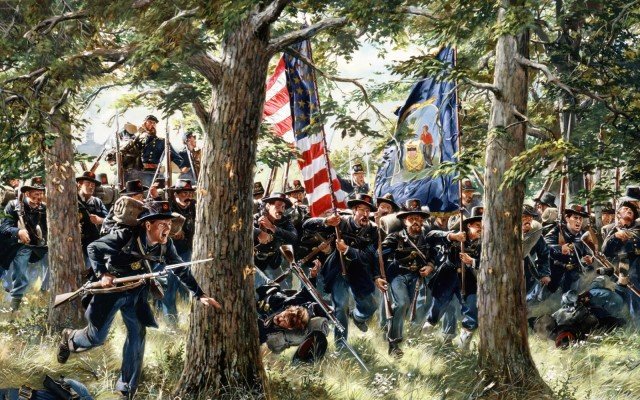

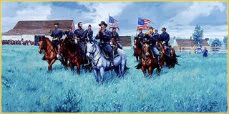
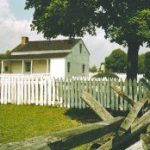
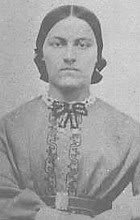
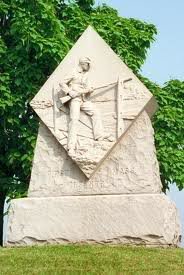
Mary McAllister served at Christ Lutheran Church on July 1. It is directly across the street from her house. Please read her interview again.